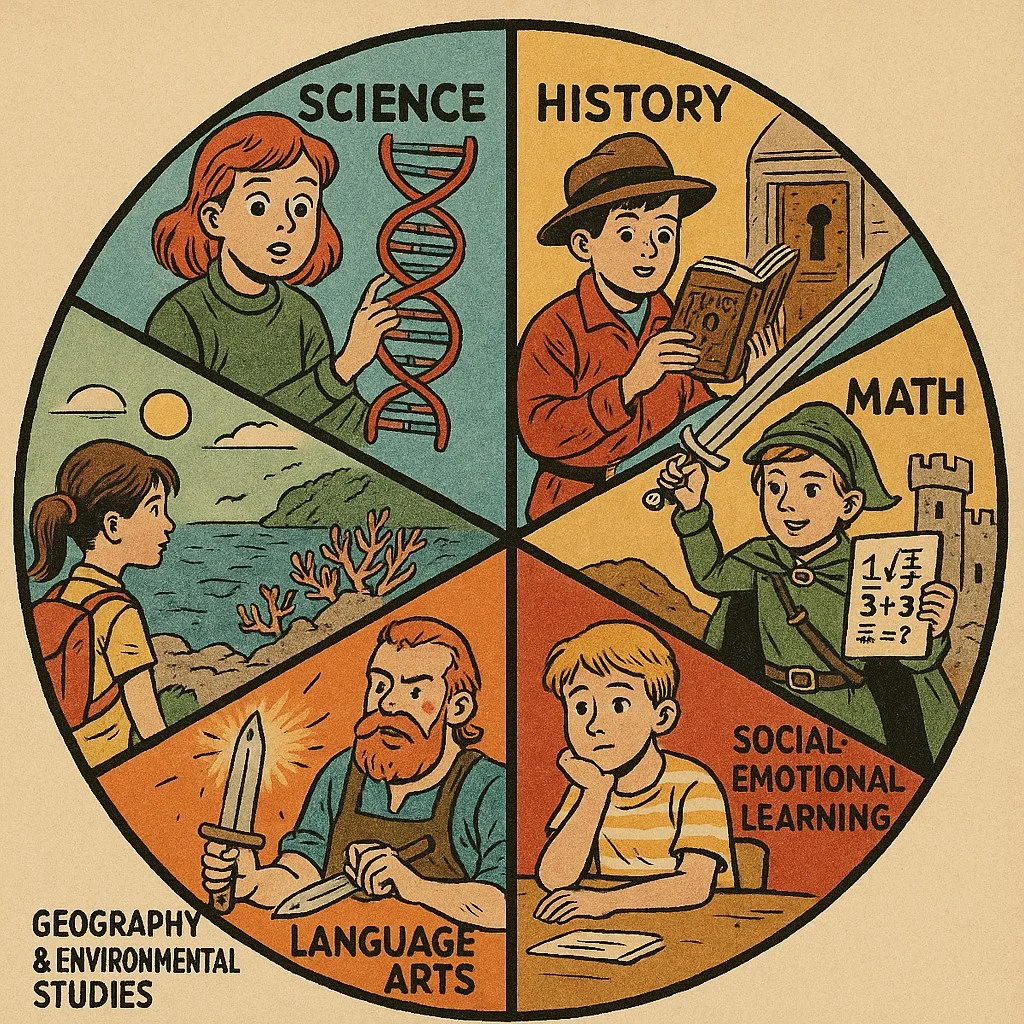How Edufiction Uses School Curricula to Spice Up Learning
“Learn something new, fall into a story, and come out smarter than before.” That’s the magic formula behind edufiction, a genre that blends compelling storytelling with educational content. Whether it’s through a time-traveling adventure in ancient Egypt or a coming-of-age tale set inside a petri dish (yes, really), edufiction transforms classroom topics into narrative gold.
In a world where traditional textbooks can sometimes fall flat, edufiction breathes life into learning—without students even realizing they’re digesting core curriculum.
Let’s take a closer look at how edufiction incorporates different school subjects and aligns with diverse genres to make learning both fun and unforgettable.
Science: When Curiosity Becomes a Plot Twist
Curriculum Connection: Biology, Chemistry, Physics
Edufiction Example: Middle Grade Sci-Fi
"The Inheritance of Matter" tells the story of a girl whose DNA is mysteriously evolving after exposure to a rogue particle accelerator. As she unlocks the secrets of her changing body, readers learn about genetics, heredity, and chemical reactions—all wrapped in a thrilling STEM adventure.
Why It Works: The science isn’t just background—it’s central to the plot. Characters use real scientific principles to solve problems, making readers feel like they’re part of the lab.
History: Time Machines, Diaries, and Hidden Truths
Curriculum Connection: Ancient Civilizations, World Wars, Civil Rights
Edufiction Example: Historical Mystery for Upper Elementary
"The Timekeeper’s Journal" follows a 12-year-old who discovers a diary that lets her travel back to major historical moments—like the signing of the Magna Carta or the Montgomery Bus Boycott. Along the way, she witnesses history through a kid’s eyes.
Why It Works: Instead of memorizing dates, kids experience them. Historical accuracy is preserved, but it's the emotional connection that sticks.
Math: More Than Just Numbers
Curriculum Connection: Fractions, Geometry, Algebra, Problem Solving
Edufiction Example: Fantasy/Quest Adventure
"The Kingdom of Variables" introduces readers to a world where every spell is solved with equations. To defeat the villain, the main character must master the “Order of Operations” and find the missing coordinates to unlock hidden realms.
Why It Works: Math becomes a tool for storytelling. Students grasp abstract concepts because they’re applied in exciting, high-stakes scenarios.
Social-Emotional Learning (SEL): Feelings Meet Fiction
Curriculum Connection: Empathy, Conflict Resolution, Mindfulness
Edufiction Example: Contemporary Realistic Fiction
"Inside Out Loud" is about a boy navigating the aftermath of his parents' divorce while working on a group project about communication styles. Through his story, readers learn about emotional regulation, active listening, and collaboration.
Why It Works: SEL is infused into the character arc. Kids relate to the protagonist’s challenges and learn SEL strategies without a worksheet in sight.
Language Arts: Grammar, Literary Devices, and All That Jazz
Curriculum Connection: Figurative Language, Writing Structure, Reading Comprehension
Edufiction Example: Meta-Fictional Fantasy
"The Sentence Smith" tells of a magical blacksmith who forges stories—literally. Each chapter focuses on literary elements like similes, foreshadowing, or plot arcs. The protagonist must repair the “Story Chain” to save his village from chaos.
Why It Works: Students are immersed in literary tools by watching them affect the world around the character. They don’t just learn plot structure—they live it.
Geography & Environmental Studies: Where Setting Becomes the Star
Curriculum Connection: Ecosystems, Maps, Cultures, Climate Change
Edufiction Example: Eco-Thriller for Tweens
"Coral Keepers" is a suspenseful tale of students stranded on an island after a science cruise goes awry. As they fight to survive and preserve the delicate reef, readers learn about ocean ecology, conservation, and climate action.
Why It Works: Geography and environmental science aren’t abstract—they’re the heartbeat of the story.
Why Parents and Librarians Love Edufiction
Curriculum-aligned: Edufiction reinforces what kids are already learning in class.
High engagement: Stories increase motivation, especially for reluctant readers.
Cross-curricular potential: Many books touch on multiple subjects at once.
Discussion-rich: Perfect for book clubs, classroom circles, or bedtime chats.
Final Thoughts
In a time where information overload and screen distractions are real concerns, edufiction offers a joyful return to deep, meaningful learning—one story at a time. Whether you're stocking a school library, building a bedtime reading routine, or designing curriculum supplements, edufiction might just be the most powerful (and sneaky) learning tool you’ll ever use.
Because in the world of edufiction, every page is a new adventure—and every adventure teaches something unforgettable.

